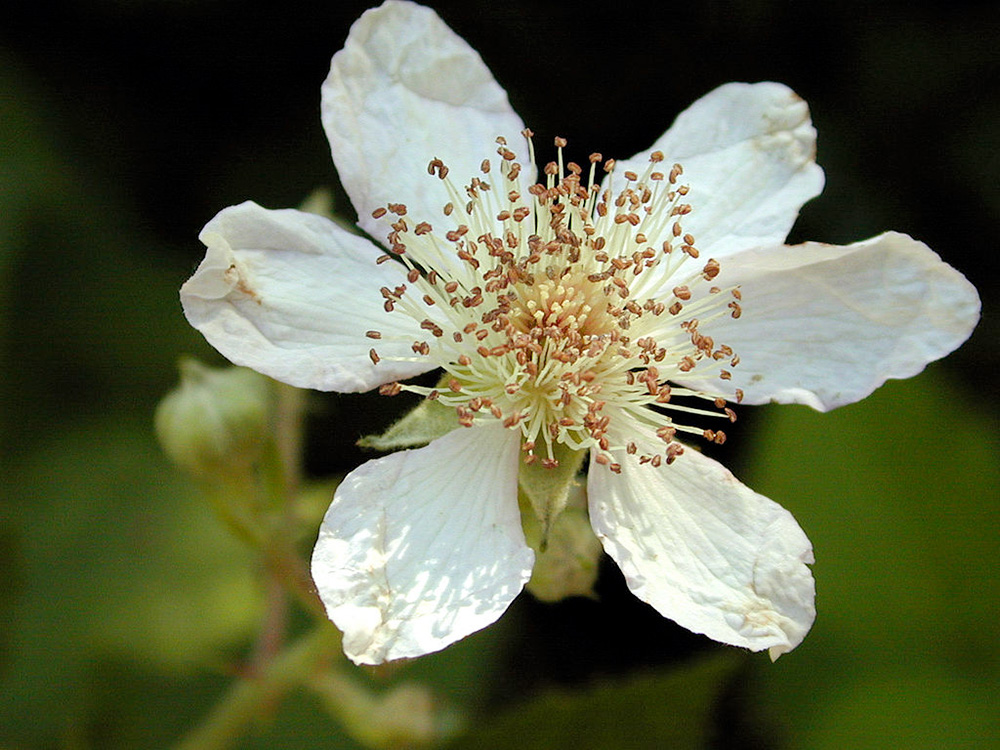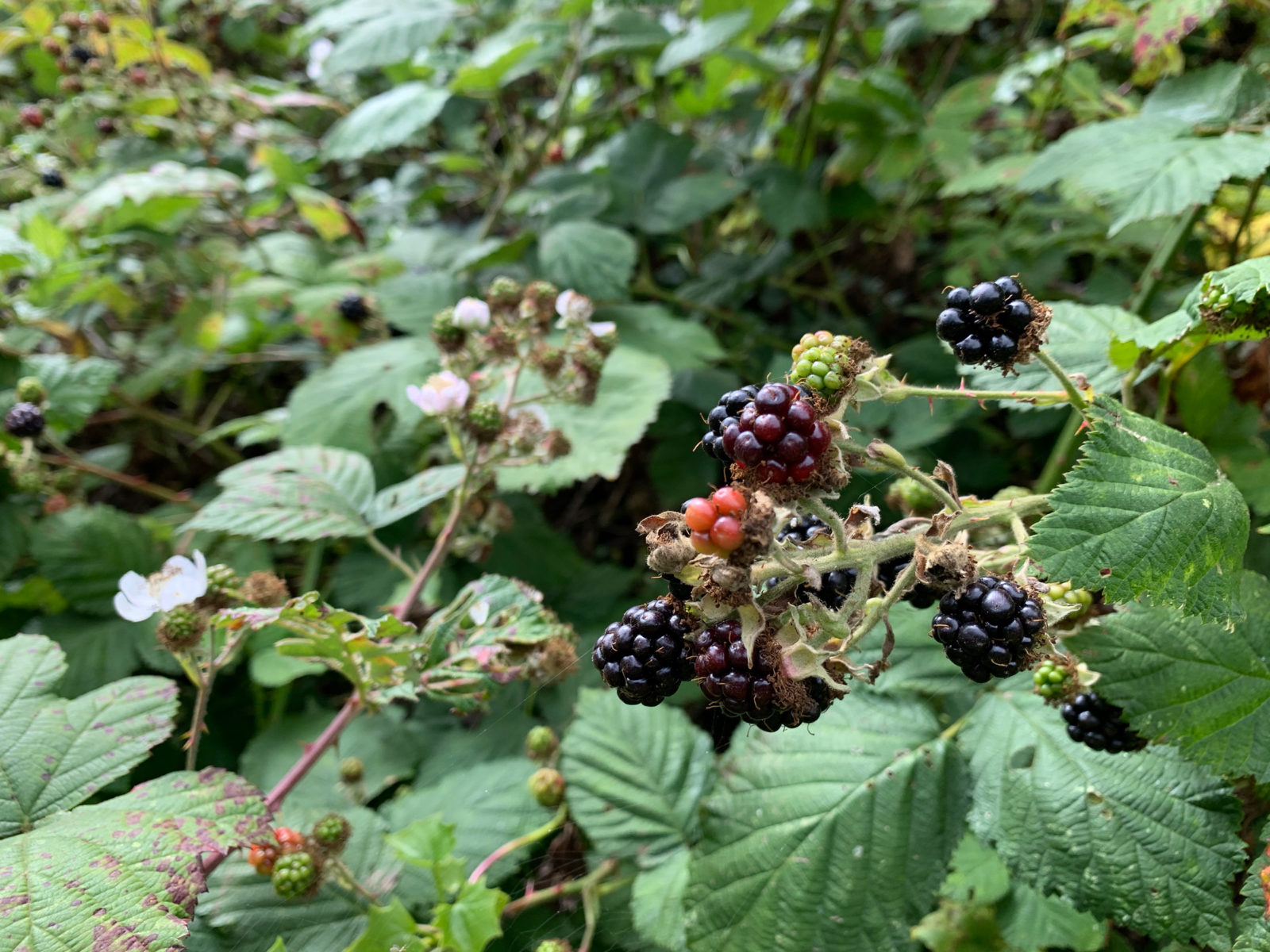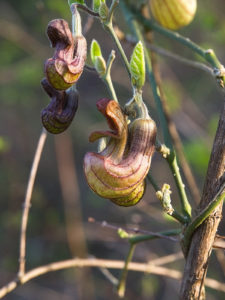With five to seven leaves resembling outstretched fingers on the palm of a hand, the blackberry Rubus armeniacus grows from curved, blood-red stalks resembling veins. Sonoma County horticulturalist Luther Burbank acquired the seeds in 1885 from a trader in India, and dubbed it the “Himalaya” blackberry, though it was actually native to Armenia and Northern Iran. In an era before patents, Burbank introduced his plants to the American market through descriptive catalogs, and rhapsodized that, “in point of fruit production, the Himalaya far surpasses any other berry plant ever grown.”
Though he was not a formally trained scientist, Burbank obsessed over breeding new and improved fruit. His unique plant creations ran the gamut from wildly successful such as the Russet Potato and Santa Rosa plum, to bizarre failures like the Nicotunia—a petunia-tobacco hybrid that (perhaps unsurprisingly) never caught on. Beyond the garden, however, it’s that sweet, potentially prickly prize of summer, the blackberry, that stamps Burbank’s influence on the open spaces of California.
Remember, they are an exotic species in the Western United States, and are rapidly increasing their geographic range and range of habitats. Are they outcompeting or excluding native species in the process? How would we know? We have done almost nothing to monitor changes in the assemblage of mushroom species in areas before and and after the incursion of death caps.
Further Reading
Pringle et al, “The ectomycorrhizal fungus Amanita phalloides was introduced and is expanding its range on the west coast of North America,” Molecular Biology 2009
Lockhart et al, “Simultaneous emergence of multidrug-resistant Candida auris on 3 continents confirmed by whole-genome sequencing and epidemiological analyses,” Clinical Infectious Diseases 2017
Battalani et al, “Aflatoxin B1 contamination in maize in Europe increases due to climate change,” Scientific Reports 2016
Blackberries at the Bulb
Though landfill on the Albany Bulb did not begin until more than a decade after Luther Burbank’s death in 1929, the peninsula, with its tidal wetlands, sandy beach, and pop up art installations is a unique place to experience the Himalayan blackberry in summer. With sweeping Bay views and a varied social history (in different decades the Bulb has been a haven for homeless, and a proposed site for a shopping mall near Golden Gate Fields), it is a distinctive stretch of land to encounter Burbank’s famed fruit. “A lot of people harvest and eat the blackberries,” Susan Moffett, program director of Love the Bulb says. “I couldn’t say if it’s technically allowed, but in reality, tons of people go out with buckets.” Pest plant or convenient crop? Perhaps befitting the Albany Bulb’s creative spirit, foragers make their opinions on the debate known with their jams and pies.
The Himalayan is still known for its large berries today. And, as many a nature enthusiast has learned in the decades since, it also has a track record of crowding out native plants.
“When it gets into an area, it establishes itself and it’s very difficult to eradicate,” says Rachel Spaeth, Garden Curator of the Luther Burbank Home and Gardens in Santa Rosa, referring to the plant’s deep roots, which layer and create shoots when gardeners try cutting them out. Still, she notes that in addition to being an important habitat for fairy shrimp, other native species share credit with Burbank for the berry’s wide reach. “Even though Luther brought it to market, it was really the birds who passed it around, and spread it in our waterways.”
In the 1880s, Burbank began a blackberry-breeding program. In a chapter called, “Thornless Blackberries—And Others,” he wrote that “the cultivated blackberry is essentially an American product,” and determined to salvage the fruit from “the prejudice against the wild bramble.” Influenced by Charles Darwin’s theory of natural selection, Burbank’s breeding experiments resulted in unique creations such as the Phenomenal Berry, a blackberry-raspberry hybrid, and the deliberately pallid White Blackberry. As a talented marketer, he was most convinced that eradicating the blackberry’s prickly thorns would revolutionize the fruit’s popularity by enabling easier harvest. After multiple breeding attempts, he was so pleased with his thornless result he predicted that, “the nursery rhyme about the wise man and the bramble-bush will probably have little meaning for our grandchildren for the brambles of their day will not have thorns.” This augury didn’t materialize, while the well-thorned “Himalayan” berry he used in his experiments became widespread. Considered a noxious, non-native weed by many and a taste treat by some, the blackberry Burbank didn’t engineer but did introduce has become ubiquitous throughout the Bay Area in August when its dark, juicy fruit heralds the waning sun-kissed days of summer.

“My daughter and I picked fifty pounds of berries from one Himalaya Bush the latter part of August, 1906,” an “enthusiast” is quoted in Burbank’s “Thornless Blackberries—And Others.” While “fifty pounds” sounds like hyperbole, Spaeth, weeding western bittercress at the Luther Burbank Home and Gardens alone amidst staff cuts and quarantine in spring of 2020, sounds just as impassioned. Though copies of Burbank’s White Blackberry, the Phenomenal Berry, and his original thornless are on view at the center in Santa Rosa, Spaeth looks forward to late summer and fall when she can pick wild Himalayans. “It’s one of the things I do with my kids. We go find our favorite creek and are careful to pick from waist high or higher because people walk their dogs there. I make a mean blackberry meringue pie.”
“You ate that first one and its flesh was sweet. Like thickened wine: summer’s blood was in it,” writes poet Seamus Heaney, in his elegy for the transience of summer, “Blackberry-Picking.” Heaney would spend a year as visiting professor at UC Berkeley, and like many in Heaney’s collections, the poem explores themes of nature, growth, and the passage of time, subjects of interest to Burbank as well. While Burbank did not have children with either of his two wives, he shared children’s stories throughout his works, and assailed “the absurdity … of running children through the same mill in a lot, with absolutely no real reference to their individuality.” Burbank rejected indoor education, writing that children should be “reared … in the open, in close touch with nature.”
Burbank wrote about wanting to breed children as well. His volume The Training of the Human Plant enthuses about selectively mingling the diverse immigrant population of the U.S. to forge a “magnificent race.” Calling the United States “more crossed than any other nation in the history of the word,” the volume is laden with unscientific eugenics, and bizarre attempts to equate humans with plants.
While the “Himalayan” expanded its wide reach, Burbank’s final years were dogged by financial controversies and health problems, as well as friendships with noted figures including Thomas Edison and Paramahansa Yogananda. In a 1926 address in San Francisco, Burbank spoke of his love for “flowers, trees, animals, and all the works of Nature as they pass before us in time and space,” before dying in April of that same year. He was buried beneath a Cedar of Lebanon at his home in Santa Rosa, his life’s work having so intrigued the Mexican painter Frida Kahlo that she depicted him in a 1931 portrait as a hybrid of man and tree, roots growing from his cadaver like veins.
This summer is one many of us in the Bay have looked forward to like no other. Now that we “human plants” have been forced indoors and away from each other, we’re eager to swim in the ocean, feel the sand on our feet, laze on the grass, and taste summer’s fruit. We’re ready for Heaney’s halcyon where, “Late August, given heavy rain and sun/For a full week, the blackberries would ripen,” and even the dreaded bramble-bush where, “briars scratched.” Like the berries that ripen on veiny stalks, summer contains both the sweetness of childhood and the prick of what we have lost. In the case of the “Himalayan” blackberry, the plant’s most desirable characteristics: plump, juicy berries, what Heaney refers to as “summer’s blood”—are due to nature, and aren’t a result of Burbank’s breeding at all.





